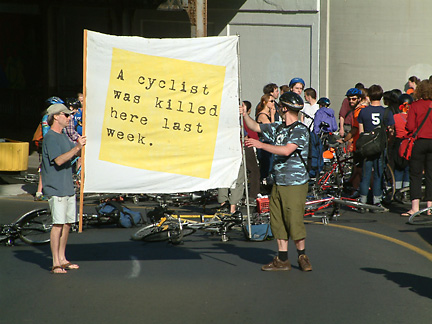
photo by Darren Stehr of Toronto Cranks
There are great photos posted online from last Wednesday's sad and lovely bike memorial (see previous post). Tino's are here, and Toronto Cranks' are here.
My friend B. and I made the banner in that photo about eight years ago. It's been displayed at each and every bike memorial that ARC has done over the years, and it's one of the few applications of my art/design skill that has had concrete, political use-value. I am extremely proud of it.
Thanks Bill for posting this link to roadsidememorial.org. This page is pretty damn sad. Highways sure have a lot to answer for.
excerpts from Toronto's Alex Wilson's book, The Culture of Nature:
In the 1950s new road-building technologies carried more people than ever before out of the cities to play in the country. In 1944 the U.S. Congress passed the Defense Highway Act, which authorized the construction of a massive national network of roads that would supposedly allow for movement of troops and materiel in case of foreign attack. In Canada, the Alaska Highway, authorized in 1948 had similar military beginnings. In 1956, U.S. workers began construction on the Interstate Highway System, aided by the revenues from a gasoline tax. The tax, in fact, could only be spent on highway construction for the first sixteen years. The highways encouraged car acquisition and use, the cars in turn consumed more gas, and the tax on the gas ensured the construction of more highways. The interstate highways, completed in the mid-1980s, amounted to a massive government subsidy to the auto industry and its many dependents, including tourism.
[...]
As the growth of rural tourism proceeded, the geographical focus shifted from natural features of the landscape to artificial ones such as golf courses or African animal-safari parks. The reasons for this are complex, but they are mostly to do with the need for the industry to differentiate its products to serve a rapidly expanding market. Marine parks and Santa's Villages, whether in California or Kansas, were like so many interchangeable brands of cigarettes or pain relievers, each with its target audience.
[...]
Originally -- in the early 1930s -- trailers were a kind of house on wheels, like a covered wagon for vacationers or itinerant workers. Now they're called mobile homes and they've become the predominant form of prefabricated housing. They are permanent features of the landscape, as the evolution of their town names indicates: from trailer camps to trailer parks to mobile-home estates. In the U.S. Southwest, these communities are simply called parks, and the trailers themselves are called park models. Temporary dwellings -- which are an ancient phenomenon -- imply a kind of freedom and have thus found a special place in the North American ideological landscape. This phenomenon is usually expressed as freedom from ties to place, to family, and to job; freedom to move across this land as we want and to make new connections with it. For people who work at migratroy or temporary jobs -- and today this includes work in sales or mid-management as well as on farms -- moving from one place to another is often a necessity. It's as if physical mobility is standing in for the dream of social mobility that North American society has been unable to deliver.
|
photo by Darren Stehr of Toronto Cranks
There are great photos posted online from last Wednesday's sad and lovely bike memorial (see previous post). Tino's are here, and Toronto Cranks' are here.
- sally mckay 5-22-2004 6:30 pm
My friend B. and I made the banner in that photo about eight years ago. It's been displayed at each and every bike memorial that ARC has done over the years, and it's one of the few applications of my art/design skill that has had concrete, political use-value. I am extremely proud of it.
- sally mckay 5-22-2004 6:33 pm
Thanks Bill for posting this link to roadsidememorial.org. This page is pretty damn sad. Highways sure have a lot to answer for.
- sally mckay 5-22-2004 7:54 pm
excerpts from Toronto's Alex Wilson's book, The Culture of Nature:
- sally mckay 5-22-2004 8:23 pm